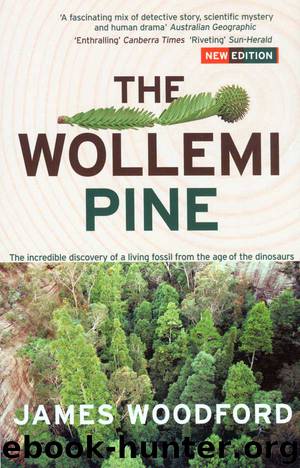The Wollemi Pine by James Woodford

Author:James Woodford
Language: eng
Format: epub
Tags: non-fiction, nature, plants, trees
ISBN: 9781921834899
Publisher: The Text Publishing Company
Published: 2012-01-16T05:00:00+00:00
Geoff Hope is an expert on tropical ice. Much of his career has been spent on the highest mountains on the equator in the wild places of Papua New Guinea and Irian Jaya. His main love is the Carstensz Glacier, a dying ice flow in Irian Jaya that is melting rapidly as the world warms. Because the effects of global warming are exaggerated on summits, the last fragments of the previous ice age are literally retreating up these mountains faster than scientists like Hope are able to monitor. In time there will be nowhere higher for the Carstensz ice to hide and it will cease to exist.
Hope is professor of natural history at the Australian National University in Canberra. On the morning I spent with him in the winter of 1998 a freezing southerly had blown in from Antarctica, dumping snow on the mountains which form a semicircle around the southern outskirts of the national capital. Hope pointed to the ceiling of his office and said ominously, ‘The Pleistocene is just up in the sky.’ He explained that snow arrives when freezing air, high in the atmosphere, drops down to lower altitudes.
On that particular morning the freezing point had come down to 600 metres above sea level. Moisture above that altitude fell as snow. The moisture was produced by a cyclone that had sat off the New South Wales coast for days, sucking water from the ocean. Simultaneously a continent-sized wall of freezing air had travelled from the Southern Ocean, across southern Australia. When these two titanic weather systems collided a climatic drama was played out in the skies of New South Wales. In an ice age, Hope told me, the freezing air higher in the atmosphere comes down and stays down. There have been around five ice ages over the last two billion years. The biggest of these is thought to have occurred before multicellular life exploded onto the world stage more than 500 million years ago. In the last 2.6 million years the world has been in the grip of an ice age but the intensity of this general cold period has been broken by spells of comparative warmth. During one such interglacial thawing 129,000 years ago coral reefs were forming as far south as Newcastle, about 130 kilometres north of Sydney. Scientists estimate that about twenty-six mini ice ages have taken place in the Pleistocene. ‘In terms of biological effects the mini ice age that ended around 10,000 years ago was a doozey,’ said Hope. ‘This one seems to have had the greatest treelessness that we can find in the record.’ He agrees with the theory that maybe people made the impact of the last mini ice age in Australia greater than those experienced previously.
Between the invading sand-dunes and the eastern edge of the Australian continent was a few tens of kilometres protected by the Great Dividing Range. If the fortress of the Great Divide’s escarpment had been breached then the consequences for Australian life forms would have been terrible.
Download
This site does not store any files on its server. We only index and link to content provided by other sites. Please contact the content providers to delete copyright contents if any and email us, we'll remove relevant links or contents immediately.
Sapiens: A Brief History of Humankind by Yuval Noah Harari(14166)
Sapiens by Yuval Noah Harari(5264)
Pale Blue Dot by Carl Sagan(4858)
Homo Deus: A Brief History of Tomorrow by Yuval Noah Harari(4777)
Livewired by David Eagleman(3624)
Origin Story: A Big History of Everything by David Christian(3590)
Brief Answers to the Big Questions by Stephen Hawking(3319)
Inferior by Angela Saini(3209)
Origin Story by David Christian(3117)
The Gene: An Intimate History by Siddhartha Mukherjee(3014)
Signature in the Cell: DNA and the Evidence for Intelligent Design by Stephen C. Meyer(2996)
The Evolution of Beauty by Richard O. Prum(2914)
Aliens by Jim Al-Khalili(2764)
How The Mind Works by Steven Pinker(2695)
A Short History of Nearly Everything by Bryson Bill(2579)
Sex at Dawn: The Prehistoric Origins of Modern Sexuality by Ryan Christopher(2441)
From Bacteria to Bach and Back by Daniel C. Dennett(2423)
Endless Forms Most Beautiful by Sean B. Carroll(2402)
Who We Are and How We Got Here by David Reich(2375)
